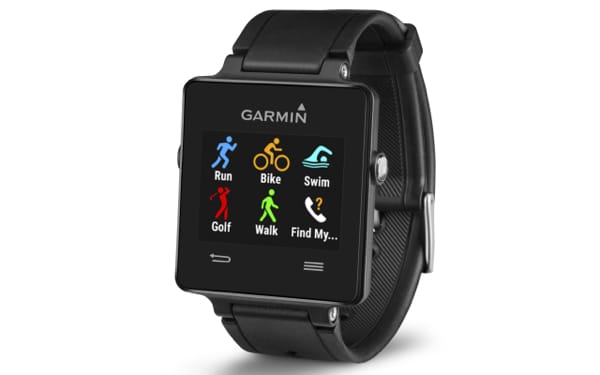Wearables Wednesday: the Garmin Vivoactive GPS smartwatch

The Apple Watch might be the wearable du jour at the moment, but there are plenty of other wearable devices that can do much of what Apple’s expensive smartwatches can, at least in terms of fitness and activity tracking.
One of the most popular devices on Amazon at the moment is the Garmin Vivoactive GPS smartwatch and activity tracker, on sale for a fairly reasonable £180.
At this year’s Consumer Electronics Show (CES) in Las Vegas, Garmin announced several devices including the new Vivoactive, which was designed as a cross between the firm’s fitness watches and the activity tracking of the Vivofit line.
But is it any good?
The lowdown on the Garmin Vivoactive
The Garmin Vivoactive is incredibly lightweight and the screen so shop that you might be forgiven for thinking that it’s a prototype. The 1.13 x 0.80 inch display is always on, making the device a perpetual wristwatch. Without the straps, it measures just 1.72 x 1.52 x 0.32 inches and weighs 0.63 ounces. It’s thinner and lighter than most other activity trackers that have smartwatch features.
When purchasing a Vivoactive, there are a couple of options – buy the tracker on its own or alternatively pair it with a Garmin chest strap. It also comes in black and white, including the both case and the wrist straps. And just like the Apple Watch, the straps can be swapped out for different colours in leather or silicone. Changing them isn’t quite so easy however as they are secured with tiny screws, though a screwdriver is included in the box.
Swiping on the touchscreen lets you navigate the menus, but there’s also a physical button on one side, as well as an almost identical button on the left to light up the screen and power off when held down. The battery life however is so long that you’ll probably rarely power down – apparently 3 weeks is the norm, a figure that even the Fitbit can’t match, never mind the Apple Watch.
The Vivoactive can also be synced via the Garmin Connect mobile app (available on Android and iOS), as well as via a Windows PC or a Mac. Mobile syncing is wireless, but doing it via a computer requires the Garmin Express desktop app and requires connection by USB cable.
Customisation
The Vivoactive allows the wearer to customise the face with different colours ,for example highlighting the hours in green while the minutes display in white. You can also reverse the display to invert the colours.
Using the Garmin Connect IQ app store lets you customise the watch even further with more screens and features. For example, a face that shows your daily step counts and whether you’ve achieved your goals for the day. The Connect IQ store is still relatively new with only a small selection of apps however.
Apple isn’t the only one using haptics in its wearables. The Garmin also use tactile feedback to vibrate and display alerts from a Bluetooth-connected Android or iOS device. Any notification that can be shown on your phone is mirrored to the Vivoactive, rather than just caller ID or text messages.
Exploring the menus, you’ll also find controls for music, a weather app based on your location, and a screen that allows you to control a Virb Elite action camera (also by Garmin).
Fitness first
The Garmin smartwatch has built-in GPS and kicks in the moment you select an outdoor activity. Besides running, bicycling, swimming, golf, walking, and indoor exercises are also supported.
On a run, the always-on screen means you can just glance down at your wrist to see distance, speed (and the time), and thankfully the display is easy to read in bright sunlight.
Once you have finished any activity, your stats sync with your Garmin account, which is then visible in the Garmin Connect app and shows a map with mile markers included.
Unlike many smartwatches, it is possible to wear the Vivoactive while swimming, as it’s rated to 5ATM meaning submersion to 50 metres is supported.
Summary
If you’re after a hybrid smartwatch and activity tracker that caters to an active lifestyle, there’s a lot to like about the Garmin Vivoactive. The main feature that’s missing however is an optical heart rate monitor that can measure your heart rate through your wrist. You can of course pair it with a chest strap, however.
Once you discover all the other things the device can do, from keeping track of your swims or your golf score, the Vivoactive seems like an incredibly useful and inexpensive gadget.
Here’s the link to buy the Vivoactive on Amazon UK.
Disclaimer: this post was not sponsored or endorsed in any way by Garmin.







